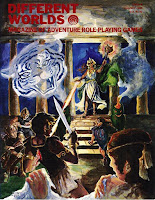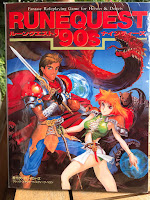OMG this is huge. I hadn’t realised there had been so many errata and Q&A published on the Chaosium’s web-site. I reckon this is going to be a very useful reference page.
About Me
23 April 2024
22 January 2024
Animal Shape-Shifters in Glorantha
 |
| cover of DW #9 |
In RuneQuest 2nd edition (their first appearance), for instance, animal shape-shifters are described as follows under the heading Lycanthropes:
“Shape changers are a lonely breed, tainted with Chaos, and disdainful of civilisation. Few know whether they are animals who can take on human shape, or humans capable of assuming the shape of an animal. In either case, they can assume the strength and senses of the animal form at the expense of some intelligence (varying as to species).
...
Lycanthropes are a very rare breed, no matter what sort of animal they become. The genes for lycanthropy are recessive, so that only matings between lycanthropes will breed true. Most children of two lycanthropes are either animal or human without shapechanging ability.
...
Their Chaotic nature gives them their abilities of shape change and invulnerability to impure metals. They do not receive any of the Chaotic Features shown in Chapter X.
...
The lycanthropes include Bearwalkers, Tiger Sons, Tusk Brothers, and Wolfbrothers.”
In HeroQuest Glorantha, animal shape-shifters are described as follows under the heading Skin-walkers — accompanied by the Beast and Spirit Runes:
“Skin-walkers are shape-changers, and disdainful of civilisation. Few know whether they are animals who can take on human shape, or humans capable of assuming the shape of an animal. In either case, they can assume the strength and senses of the animal form at the expense of some intelligence (varying as to species), with its natural weapons.
...
The skin-walkers known in Dragon Pass and the Holy Country include Bearwalkers, Tiger Sons, Tusk Brothers, and Wolf Brothers. Only the Wolf Brothers are described in further detail here. The God Learners classified them as a type of primitive men they called Hsunchen or Hykimi. There are dozens of different types of Hsunchen throughout the rest of Glorantha.”
In a nutshell, RQ2 tells us that animal shape-changers are lycanthropes tainted by Chaos, whereas HQG describes them as a sort of peculiar Hsunchen. Well, that’s completely different: lycanthropes are basically monsters, whereas Hsunchen are primitive humans. Also, the connection to the Chaos Rune has been replaced by a connection to the Beast and Spirit Runes.
Worse yet, the most recent material (the RQG line) is completely devoid of any references to animal shape-shifters other than the Telmori. The Guide to Glorantha merely mentions (on page 484) that one of the towns in the East Isles has a Tiger Son Guard “comprised of Hsa were-tigers”, which simply adds a layer of confusion since ‘Hsa’ is the name of the tiger Hsunchen tribe according to the Guide (p439 and p561).
It is simply impossible to try and figure out which interpretation is correct (‘monsters’ vs ‘primitive humans’) given the current canon.
A further research on each type of animal shape-changer in the Gloranthan corpus doesn’t provide any particular help either:
A search on ‘Bearwalker’ returns a mention of “the Rathori Bearwalkers from the forests of northern Genertela” in HeroQuest Glorantha, and a very similar one in the Glorantha Sourcebook.
In the HQ supplement Sartar: Kingdom of Heroes, ‘Bearwalkers’ is the name given to the initiates of Odayla (p110). In its sister publication Sartar Companion, there is a description of such an NPC (p133), who “attacks and kills Telmori or Chaos on sight and without hesitation”. We are very far from the Chaotic nature of RQ2 Bearwalkers...
In RQG, ‘Bearwalkers’ is the name given to Odayla Rune Lords (RQG core rules p300, and the Lightbringers p124).
A search on ‘Tiger Son’ returns a long, unofficial article in Different Worlds issue No.9, and a mention of a Tiger Son initiate of Zorak Zoran in Big Rubble.
A search on ‘Tusk Brother’ doesn’t return anything.
⁂
So, to summarise:
★ In early Glorantha (end of the 70s, beginning of the 80s), lycanthropes were animal shape-shifters tainted by Chaos. According to the official rules, you had to be born a lycanthrope, whereas Big Rubble and Different Worlds issue No.9 seemed to imply you might become one via a cult.
★ In the early 2010s (at the time of the Guide and of HeroQuest Glorantha), the concept of ‘animal shape-changers’ seems to have become interchangeable with ‘Hsunchen’. The association with the Chaos Rune is gone, except for the Telmori.
★ Today, with the RQG line, there is no all-encompassing concept any longer. You have the Chaotic Telmori; you have the Bearwalkers who are the Rune Lords of Odayla; Tiger Sons and Tusk Brothers have disappeared. As for the Germanic prefix were-, it is used in the Glorantha Bestiary for the Ducks who are “sometimes called durulz or were-ducks” (p31), even though... they are not shape-changers, they are Beast Men! The inconsistency is total.
11 January 2024
R.I.P. Jennell Jaquays
Jennell Jaquays (14 Oct 1956−10 Jan 2024) has passed away. She was one of the last giants of the gaming industry from the Golden Age, on par with Greg Stafford and Steve Perrin.
 |
| The Dragon, issue 21, cover by Jennell Jaquays |
Jennell Jaquays’ peculiarity was that she was an accomplished artist: writer, illustrator, miniature sculptor, and even magazine editor. She also worked in the video game industry. Another peculiarity is that she will be remembered both for D&D classics (Dark Tower, Caverns of Thracia) and non-D&D classics (Griffin Mountain, probably the very first RPG sandbox, and the Flying Buffalo City Books).
She even left her name as a verb: “jaquaying” a dungeon means rendering it less linear, providing several entrances and ways out, and most importantly designing it so that important encounters needn’t appear in a pre-definite order of succession.
More about Jennell Jaquays’ legacy at Designers & Dragons.
23 November 2023
Black Friday 2023
Here is a summary of all the offers I have spotted until now (to be regularly updated):
Chaosium — use the code BLACKFRI23 at check-out and get 10% off your order on chaosium.com
Mindjammer Press — 30% off all their digital products at DriveThruRPG
Lamentations of the Flame Princess — 25% off all their PDFs at DriveThruRPG
Osprey Games — 30% off Jackals and its supplements, 30% off Righteous Blood, Ruthless Blades, 30% off Romance of the Perilous Land; both dead tree and PDF
Lots of Jonstown Compendium items are discounted.
LULU — use the code TWINKLE30 and get 30% off all print orders.
15 June 2023
Dragonbane
The Basic Role-Playing System (aka ‘the Chaosium system’) started out as a very slim introductory booklet with just the barebones D100 rules. It wasn’t sold separately but was a free addition to many of the early Chaosium role-playing games that were sold in boxes.
The first game that was marketed as an expansion of the BRP System per se was the boxed set titled Worlds of Wonder, which contained three mini-games that used the same core rules applied to three different genres: fantasy, super-heroes, and sci-fi.
The fantasy mini-game was called Magic World [not the same as the later standalone frp game]; it was translated to Swedish and published as a standalone game in 1982 under the name Drakar och Demoner (Swedish for ‘Dragons and Demons’). As with many BRP-derived games, it went through a tortuous life of its own, changing publishers and/or names several times, and even having a system overhaul once before getting back to the BRP System (albeit with D20 instead of D100, à la Pendragon).
The game was purchased by Fria Ligan (Free League Publishing) in 2021, and is now coming back in English as ‘Dragonbane’. Fria Ligan already own several successful role-playing games, and apparently Dragonbane has adopted a few features from them.
Anyway, I’ve downloaded Dragonbane’s Quickstart, and I will try and highlight the differences I have found with the Basic Role-Playing System.
Attributes
SIZ has disappeared. As a result, HPs are equal to CON instead of ½(CON+SIZ) or CON with SIZ-dependent adjustments.
Power points/magic points are called willpower points (WPs) and are used for special actions on top of spellcasting.
Game System
A ‘1’ is a crit, and a ‘20’ is a fumble, instead of having more refined D100-based values.
There is a system of boons & banes à la D&D 5E where you roll an additional D20 for each boon/bane and count only the lowest/highest result.
There is also a ‘push’ system like in CoC 7th ed., but it can quickly result in your character getting a bane.
Combat
Each combatant has a single action for each combat round.
Initiative is 1-10 and drawn from a set of numbered cards. Meh.
Parrying is a fully-fledged action and uses up your single action. Meh.
You can do nothing during a round and recover 1D6 WPs. Given the prevalent use of WPs this is pretty cool.
When you roll a crit in combat you get to choose amongst three different effects (double damage, extra action, ignore armour) rather than automatically apply a given effect. This is super cool.
Weapons get damaged more easily than in the BRPS because whenever the armour protection completely negates the damage from a melee attack the attacking weapon itself suffers the damage instead. Ouch.
There aren’t any hit locations. If an opponent is partially covered by an obstacle, you get a bane on your attack.
Monsters
This is where Dragonbane shines: each monster has its unique abilities and attack table. The GM rolls on this table when it is the monster’s initiative (also randomly from the cards). A monster never rolls the dice to hit its target: monster attacks succeed automatically.
I really, really like this. Obviously I haven’t tested this in actual play, but I’d love to see some monster fear instilled back into my players’ eyes. Today they’re only afraid of criticals.
As an example, the giant spider from the sample adventure in the Quickstart has the following attack table:
It’s obviously massive work at the GM’s side to build such a table for each monster in their campaign. However, I really feel like this is the major innovation in Dragonbane.
⁂
Given the similarities with the BRPS I reckon any GM could pick and choose whatever they like best from this game to add flavour to their BRPS games. I guess you should at least download the Quickstart (available for free on DriveThru or directly here).
08 June 2023
Ultra-Fast As-You-Go Character Generation
QuestWorlds features a character generation option called the ‘As-You-Go
Method’: instead of fully statting your adventurer at the beginning of the campaign,
you simply sketch it to have a general idea and then you fill your ability slots
during the course of the game whenever you need to roll under an ability, i.e.:
When events in the story put you in a situation where you want to overcome a story obstacle, or discover the answer to a story question, make up an applicable ability on the spot.
Today’s post is a suggestion to try and use this method for RuneQuest. However, instead of “making up an ability” you will choose among the skills printed on the RQ character sheet.
As with my previous character generation methods, this should work for any character type, except the assistant shaman.
Character Concept
Create a character concept: a homeland, that will give your adventurer
their starting languages, and a general profession/background, that will give them
reasonable equipment when needed.
Characteristics
Do not roll for characteristics but freely assign the following values:
9, 11, 12, 13, 14, 15, 17 to your characteristics, +4 extra points.
Do not apply the Rune or Homeland modifiers to characteristics (p53 of
the core rules) as the values above have already taken them into account.
Compute the skill category modifiers per the rules.
Passions
Reserve three slots for three starting Passions: one at 70% and two at
60%. You will assign them during the course of the game.
Runes
Reserve three slots for three Elemental Runes: one at 60%, one at 40%,
and one at 20%. You will assign them during the course of the game.
On top of this, you will be able to add an extra +10% (or +5% twice) to any
of these Elemental Runes during the course of the game.
You have a grand total of 50 percentage points that can be added to any Power/Form
Runes (max. +25%) during the course of the game.
Skills
Reserve 20 slots for 20 skills that will be improved during the course
of the game. You have a grand total of 450 skill points that can be added to
these initial skill values during the course of the game. You needn’t use all
of the 20 slots – that will depend on whether you want to end up with a specialised
adventurer, or one with a broader set of skills. Instead of improving a skill, you may also use a slot to add a new Passion that will start at 60% + the amount of skill points used up.
Skills that fully correspond to the character concept can be raised up
to 100%.
Skills that are close to the character concept can be raised up to 75%.
Skills that are unrelated to the character concept can be raised up to 50%.
Cult
Once you
have chosen which cult your character will be initiated into, distribute +45
skill points among three to four skills that fit in with the deity’s portfolio
or with the deity’s Runes, e.g., Speak Darktongue for an initiate of a Darkness
deity.
You also get to choose 5 points of Spirit Magic amongst the cult’s available spells. Your adventurer receives 3 Rune points dedicated to their cult, and an extra Passion at 60% amongst the ones listed under their cult.
02 June 2023
New BRP Handouts
The Chaosium has just made available a free, 21-page downloadable PDF booklet with all the useful Basic Role-Playing tables and charts from the new edition of the Basic Role-Playing System.
Amongst what the booklet contains, I have found the following as being the most interesting:
★ the Optional Rule Checklist (this is really super useful for all the GMs who like tinkering and, well, if you’ve purchased the Basic Role-Playing System I guess you do),
★ a matrix with all (?) the possible results between attack, parry, dodge, etc. depending on the skill success levels,
★ a summary of fumbles, wounds, etc. and their effects,
★ and last but not least a summary of personality traits and reputation effects [new to this edition if I’m not mistaken].









